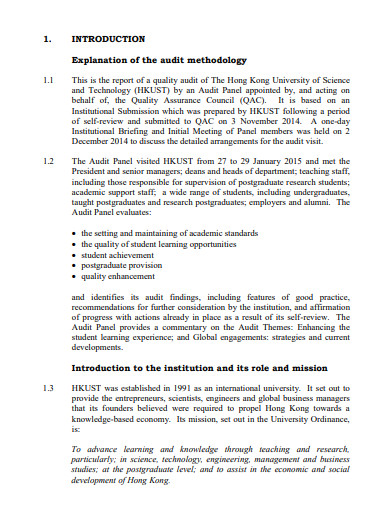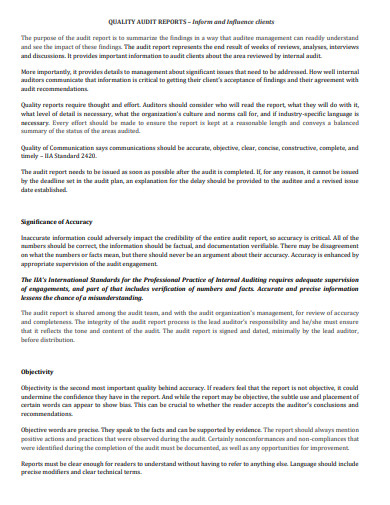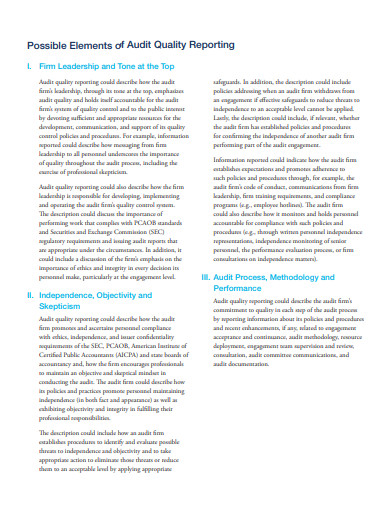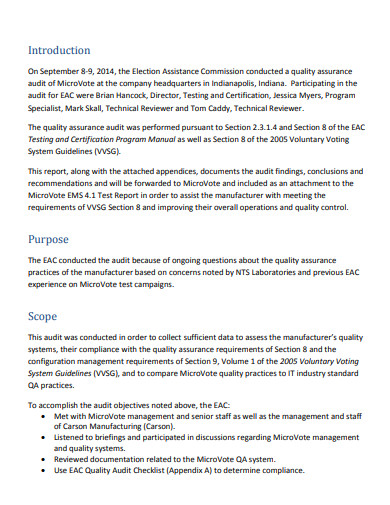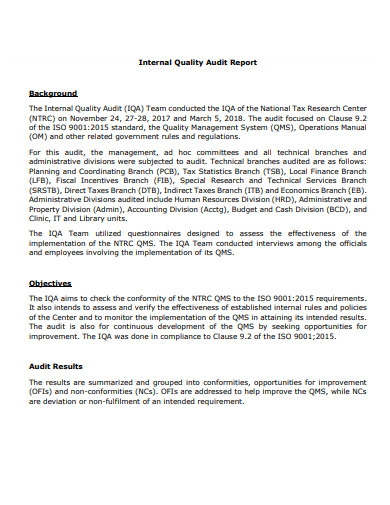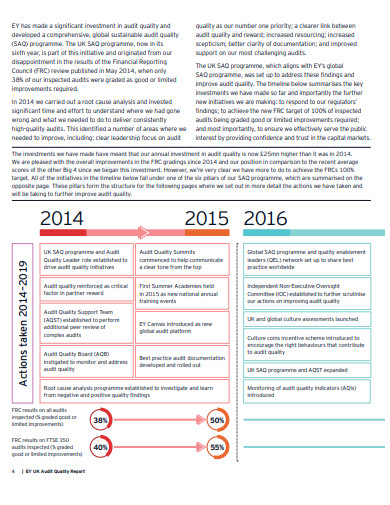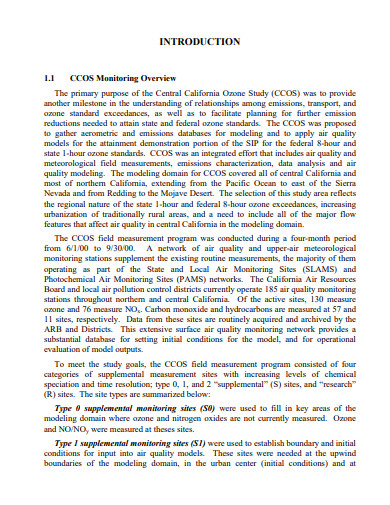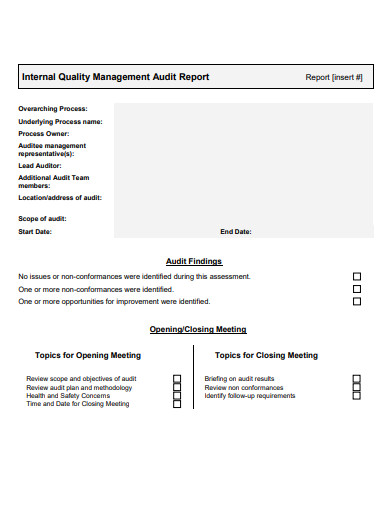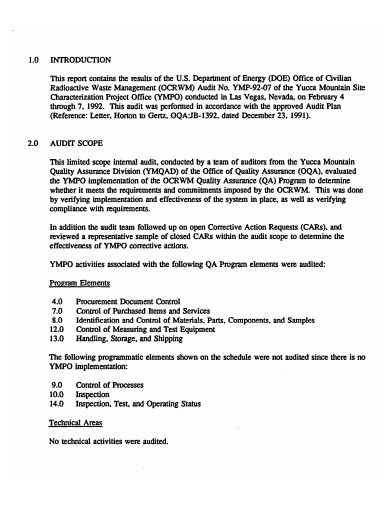10+ Quality Audit Report Examples to Download
Whether you’re a part of a private company or public company, it’s undeniable that your business entity wants only the best qualities for its products, services, projects, and processes. This is why they produce quality management plans that include quality assurance plans and quality control plans as their subsections. But aside from that, they also produce audit plans to ensure that both the business offers and undertakings are in compliance with the standards. The latter plan may include an audit checklist, a corrective action plan, and other auditing related clauses. To keep track of this plan’s activities, a quality audit report must also be produced. For guidance in making such a report, you can check out our article and examples below!
10+ Quality Audit Report Examples
1. Quality Audit Report Template
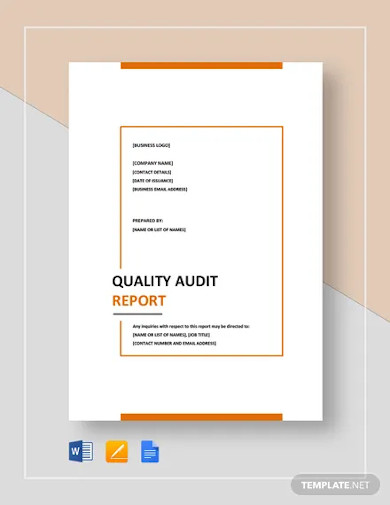
2. Internal Quality Audit Report Template

3. Quality Audit Report Example
4. Client Quality Audit Report
5. Audit Quality Reporting Template
6. Sample Quality Audit Report
7. Internal Quality Audit Report
8. Sustainable Quality Audit Report
9. Quality Assurance Audit Report
10. Internal Quality Management Audit Report
11. Basic Quality Audit Report
What Is a Quality Audit Report?
A quality audit report is a document that thoroughly presents the findings of any evaluation or analysis for quality. Jim Smith stated in his article for Quality Magazine that such a document helps both stakeholders and auditors to complete their monitoring activities and succeeding audits. He also mentioned that positive actions, practices, nonconformity, non-compliance, and opportunities must be included in the report. In another aspect, this type of report is important in many ways. One of them, and probably the greatest, is its function to act as the basis of corrective and preventive measures.
Exceptions In Audit Reports
Even though a quality audit report must be made thoroughly, there are still some aspects that auditors have to put into special consideration. Here are some of the situations:
1. Proprietary information, such as production methodologies, secret formulas, and processes, must be handled carefully. The documentation procedure in regards to that information has to be done with consent by both auditee and auditors. If nonconformities are determined, they should be written as part of separate procedure documentation.
2. Pieces of evidence that involves fraud and abuse should be handled distinctively. Aside from expressing them in a separate official letter, they should be dealt with by the auditee’s legal department.
How To Create a Quality Audit Report
Government regulations, international guidelines, and the procedures of a company are the main basis of a quality audit report. This fact imposes that such a report has to be done meticulously. With so many criteria to follow, we understand why many individuals, especially the auditors, find the task of making the report so daunting. To help you ease things up, we’ve provided you with the standardized outline below.
1. Put Up the Cover Page
Start your quality audit report with a cover page. This must consist of the report’s title, the name of the auditee, the author, and the date of completion.
2. Compose the Executive Summary
After putting up a cover page, compose the executive summary. This will provide the concerned readers the general information about the report, including its purpose, sources, procedure, and suggestions.
3. Make an Introduction
As mentioned above, this type of report is intended to unveil the findings of quality-related evaluations or analyses. With that being said, your introduction must sum up the auditor’s intentions for conducting the audit and a summary of the noteworthy discoveries.
4. Define Terminologies
Readers need to understand both the laymen’s terms and the technical ones in this report. Since a written report is a formal document, it is expected that the author adopts technical writing. For this very reason, you have to put up a section where you can define the terms that are rarely used in day to day conversations. Acronyms must also be described.
5. Discuss Quality Assurance Procedures
Quality management has four phases. They include planning, quality assurance, quality control, and continuous improvement. In this document, you’re gonna need to look up to the performance documentation and discuss what quality assurance procedures are being used.
6. Present the Audit Plan’s Proponents
Once you’ve successfully explained the quality assurance procedures, the next thing to do is to present the audit plan’s proponents. For this portion, you have to identify who the auditors are and how they qualify to become a part of the proponents. Also, you have to make a complete list of the paperwork you have looked into, as well as the people you have interviewed.
7. Bring Up the Audit Process
Now that you’ve presented the audit plan’s proponents, you can then showcase how the audit became a success. The necessary processes information that you need to include in this section can be illustrated easily through a flowchart.
8. Finalize With Recommendations
To conclude your report, create a list of recommendations on how to correct the identified nonconformities and non-compliance. When setting these suggestions, you have to make sure that it accords to the government regulations, international guidelines, and the auditee’s company procedures.
FAQs:
What are the types of audit?
Audits have three types. They include the following:
1. External Audits – These are audits that are performed by parties outside the organization under audit.
2. Internal Audits – These refer to audits that are performed by in-house auditors who are typically internal employees that are appointed by the management team or board of directors.
3. Internal Revenue Service (IRS) Audits – These are audits that are periodically performed to check up on the taxes and taxpayers.
What are the simple steps in conducting quality audits?
Conducting quality audits can be done in five simple steps – planning, preparing, executing, concluding, and monitoring.
What are the different kinds of audit reports?
Audit reports can take four forms, namely a disclaimer of opinion, an unqualified opinion, a qualified opinion, and an adverse opinion.
One of the leaders in the internal audit profession Larry Sawyer once said, “For every operation audited, know the mission, the purpose, and the reason for being.” Auditing, especially on products, services, or operations’ qualities, is done for the intention of meeting customer satisfaction. Both the employees and stakeholders have to learn this aspiration to make sure that the audits are done appropriately. The results of these audits are just as important as their very purpose because they make way for another audit with greater intentions that could have better results. In view of that fact, quality audit reports are essential for those undertakings.



